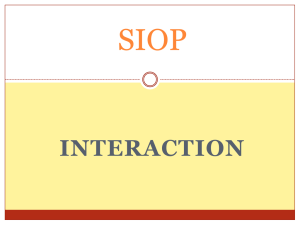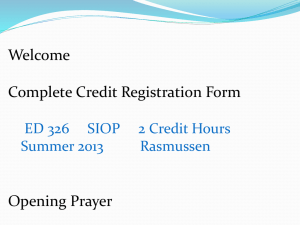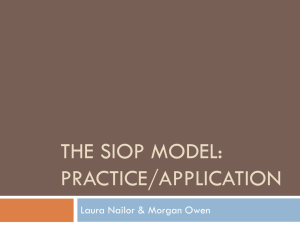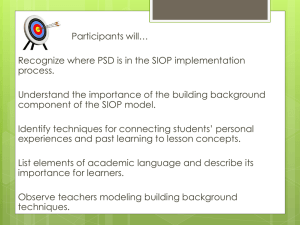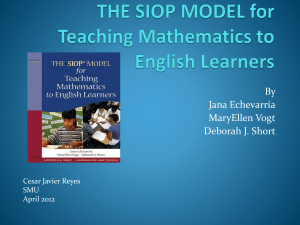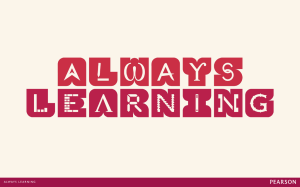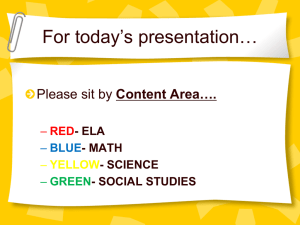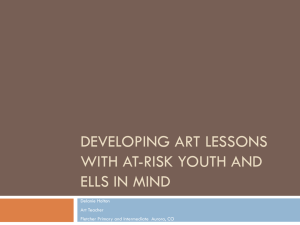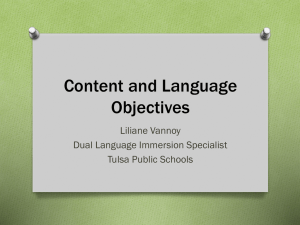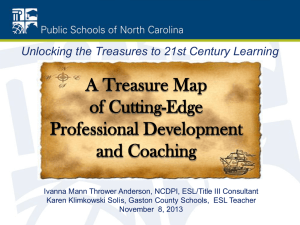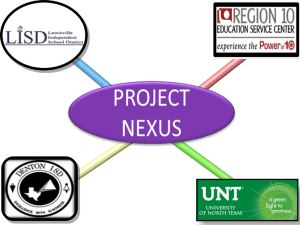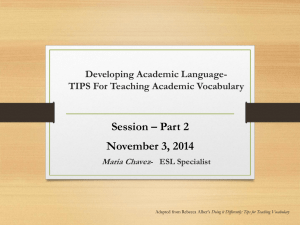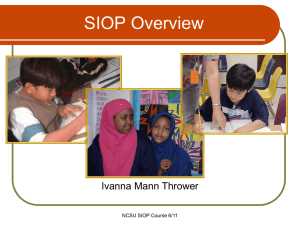SIOP With a Splash
advertisement
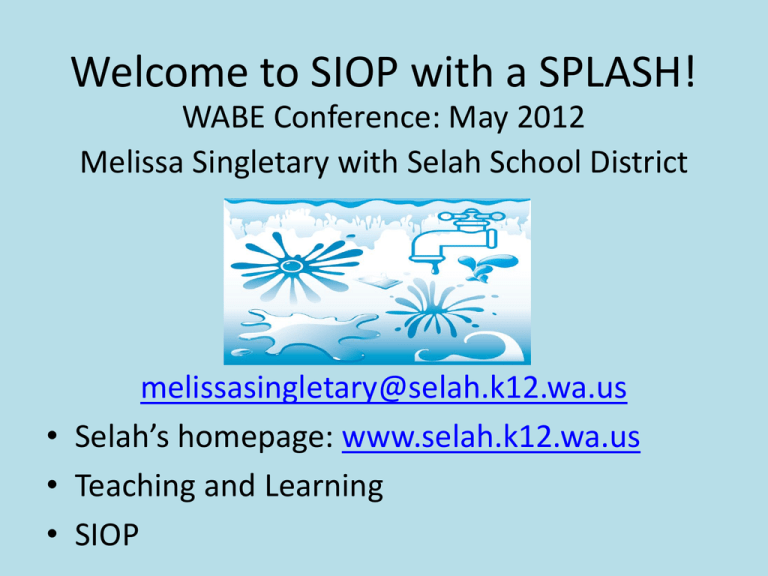
Welcome to SIOP with a SPLASH! WABE Conference: May 2012 Melissa Singletary with Selah School District melissasingletary@selah.k12.wa.us • Selah’s homepage: www.selah.k12.wa.us • Teaching and Learning • SIOP Key Outcomes: 8 Components of SIOP SIOP Acronym Sheltered Instruction/ Cooperative Learning Strategies Recommended Resources What is SIOP? • SIOP is an instructional framework that consists of 8 components and 30 features overall. • It has a Pre K-grade 12 focus. • Includes a protocol so teachers can strive for effective teaching in all areas as well as reflect. • SIOP is well known for it’s effectiveness with ELLs but its components are just simple, good quality teaching! Sheltered Instruction in Selah AKA “SIOP” • • • • • • ESD 105 Building Team: SIOP, GLAD Tier 1 & 2 Building SIOP trainings District K-4 trainings: certified and classified District K-12 trainings Trained SIOP Teams per building K-12 Building Focus- SIOP 2 and 3: model/learn, plan, use, share • Team planning to differentiate the core and include SIOP/GLAD strategies Conga Line 1. Make 2 lines facing each other 2. Assign something to review/discuss 3. Pairs share until the music begins 4. One line dances in place and the other moves down a few places-misplaced people conga down the line to find their new partner • Use sentence frames *Mingle Monday- fluently read revised writing (1st) SIOP: Sheltered Instruction Observation Protocol Sheltered: Make a house with your arms Instruction: Scoop with your arms and then bring them to your head Observation: Lookout over forehead Protocol: Pretend to complete a checklist SIOP Motto ESD 105 Teach to the high, support the low and scaffold all the way up SIOP Instruction that impacts all students SIOP has 8 Components: • • • • • • • • #1 Lesson Preparation #2 Building Background Knowledge #3 Comprehensible Input #4 Strategies #5 Interaction #6 Practice and Application #7 Lesson Delivery #8 Review and Assessment #1 Lesson Preparation • Content Objectives (the What) • Language Objective (the How) • Content Concepts (Curriculum) • Supplementary Materials • Adaptation of Content • Meaningful Activities Content / Language Objectives • Content Objectives: (GLE’s) What students need to learn • Language Objectives: How to show that learning has taken place (reading, writing, listening, speaking) #2 Building Background • Concepts Explicitly Linked • Links Explicitly Made • Key Vocabulary Find Someone 1. Assign a question for students to discuss 2. Provide time for students to process independently 3. Ask students to “find someone” with the same characteristic. For example: Sole partner 4. Students find their partner “mate” and share *Make a list and put in a can for easy use #3 Comprehensible Input • Speech • Clear Expectations • A Variety of Techniques Fact and Opinion Cadence- Use with Read Naturally Facts and opinions are really neat They help us understand what we read Facts are true and can be proven Opinions are what you think or believe in Sound off: Sound off: Sound off: 1, 2, 3, 4 Facts are true and can be proven Sound off: Sound off: Sound off: 1, 2, 3, 4 Facts are true and can be proven 1, 2, 3, 4 Facts are names Facts are dates Facts are numbers FACTS! Opinions are what you think or believe in Opinions are feelings Opinions are changeable Opinions are unprovable OPINIONS! Opinions are what you think or believe in FACTS and OPINIONS! #4 Strategies • Learning Strategies • Scaffolding Techniques • Questions or Tasks that Promote HigherOrder Thinking Skills Jigsaw/Experts 1. Assign a text to be read 2. Break it into as many parts as members in the group 3. Assign each group member one part to read *Scaffolds? 4. Provide time to read 5. Group members share what they read *Process grid, graphic organizer #5 Interaction • Interaction • Grouping Configuration • Wait Time for Student Responses • Clarify Key Concepts in L1 (students primary or first language) Graffiti Write/ Jump N Jot 1. Break the class into groups 2. Assign a topic or question 3. Provide time to process/think 4. Give each group a poster and a set of pens- one different color per student 5. Have students respond to your question in pictures, words, phrases or sentences- all write on the same poster paper *Can be a review, formative assessment or summative assessment The goal is for all students to be engaged 90% of the time! #6 Practice and Application • Hands-on Materials and Manipulatives • Apply Content and Language Knowledge • Language Skills Anchor Charts • • • • GLAD Pictorial Input Chart GLAD Process Grid Graphic Organizers Pinterest: Anchor Charts- modify • • • • Color Code Brain Imprinting Proximity Resource to refer to over time (add) *Pair with a chant #7 Lesson Delivery • Student Engagement • Lesson Pacing The 5-2-1 Model 5 = Teacher Talk 2 = Process Time 1 = Student Share Time For older students/ GLAD method: 10-2 #8 Review and Assessment • Review of Key Vocabulary • Review of Key Content Concepts • Feedback • Assessment of Student Comprehension and Learning Stay and Stray 1. Put students into groups of 3 to 5 people in different areas of the classroom 2. Provide a question that students know a lot about (different question per group) 3. Give them time to think and share aloud within their group 4. Have the group generate a poster with words, pictures, phrases and/or sentences that capture key information about that question. Each person needs to be involved in making and being able to explain the content. 5. Randomly assign one person to “stay” and share the groups’ work as the rest of the members and groups rotate or “stray” 6. Repeat rotation- the person who stays this time may be a new person or the previous one… *Works nicely with “numbered heads” Kagan Cooperative Learning • Dr. Spencer Kagan & Miguel Kagan (All Grades) The book that started it all—is all NEW! Why would the Kagans completely revise and revamp a classic that has sold nearly half a million copies? The answer: So much has changed! Cooperative Learning today is different. This new book presents today's most successful cooperative learning methods. The Kagans make it easier than ever to boost engagement and achievement. You'll still find all the practical and proven Kagan Structures, including Numbered Heads Together, RoundTable, and Three-Step Interview—direct from the man who invented cooperative learning structures. And there's still plenty of ready-to-do teambuilding and classbuilding activities to make your class click. But in this expanded edition, you will find new step-by-step structures, hundreds of helpful management tips, many more teacher-friendly activities and forms, and up-todate research on proven methods. You hear how schools have used Kagan Cooperative Learning to boost academics, close the achievement gap, improve student relations, and create a more kind and caring school community. After decades of training and working with hundreds of thousands of teachers, Kagan has refined and perfected the most widely used and respected form of cooperative learning ever. The Kagans make it easy for you to dramatically increase engagement and achievement in your class! 480 pages. BKCL • $44 SIOP • Making Content Comprehensible for English Learners: The SIOP Model, 3rd Edition • By Jana J. Echevarria, MaryEllen Vogt, Deborah J. Short • Pub. Date: Apr 25, 2007 by Allyn & Bacon. • ISBN-10: 0-205-51886-9 • ISBN-13: 978-0-205-51886-9 • List Price: $55.99 *SIOP books for different grade bands and content areas For a more in-depth and formal training please attend a Pearson SIOP training Key Outcomes: 8 Components of SIOP SIOP Acronym Sheltered Instruction/ Cooperative Learning Strategies Recommended Resources
